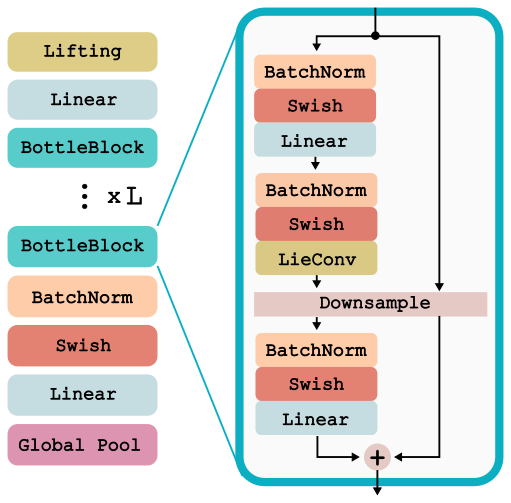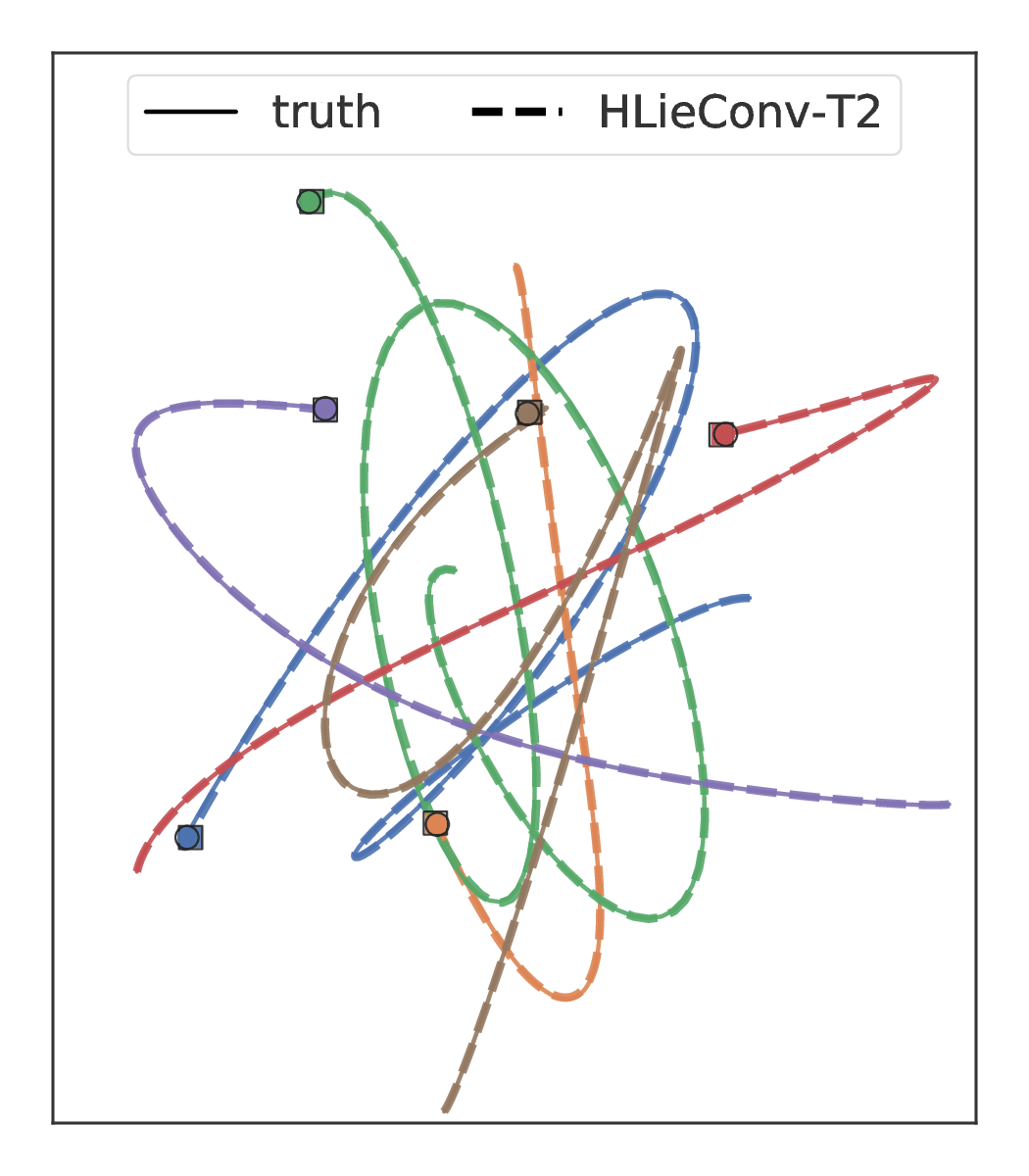Ecosyste.ms: Awesome
An open API service indexing awesome lists of open source software.
https://github.com/mfinzi/LieConv
https://github.com/mfinzi/LieConv
Last synced: 3 months ago
JSON representation
- Host: GitHub
- URL: https://github.com/mfinzi/LieConv
- Owner: mfinzi
- Created: 2020-02-25T04:10:22.000Z (over 4 years ago)
- Default Branch: master
- Last Pushed: 2023-04-27T02:36:24.000Z (over 1 year ago)
- Last Synced: 2024-04-20T17:00:08.490Z (7 months ago)
- Language: Python
- Size: 30.7 MB
- Stars: 252
- Watchers: 11
- Forks: 33
- Open Issues: 2
-
Metadata Files:
- Readme: README.md
Awesome Lists containing this project
README
# Generalizing Convolutional Neural Networks for Equivariance to Lie Groups on Arbitrary Continuous Data
This repo contains the implementation and the experiments for the paper
[Generalizing Convolutional Neural Networks for Equivariance to Lie Groups on Aribitrary Continuous Data](https://arxiv.org/abs/2002.12880)
by [Marc Finzi](https://mfinzi.github.io/), [Samuel Stanton](https://www.sdstanton.com/), [Pavel Izmailov](https://izmailovpavel.github.io/), and [Andrew Gordon Wilson](https://cims.nyu.edu/~andrewgw/). [](https://codeclimate.com/github/mfinzi/LieConv)

If you find our work helpful, please cite it with
```bibtex
@article{finzi2020generalizing,
title={Generalizing Convolutional Neural Networks for Equivariance to Lie Groups on Arbitrary Continuous Data},
author={Finzi, Marc and Stanton, Samuel and Izmailov, Pavel and Wilson, Andrew Gordon},
journal={arXiv preprint arXiv:2002.12880},
year={2020}
}
```
## Introduction
LieConv is an equivariant convolutional layer that can be applied on generic coordinate-value data and instantiated with the symmetries of a given Lie Group. LieConv was designed with rapid prototyping in mind, we believe that researchers and engineers should be able to experiment with multiple symmetry groups rather than being locked into using a given symmetry by the method.

## Installation
To install as a package, run `pip install git+https://github.com/mfinzi/LieConv#egg=LieConv`. Dependencies will be checked and installed from the setup.py file.
To run the scripts you will need to clone the repo and install it locally. You can use the commands below.
```bash
git clone https://github.com/mfinzi/LieConv.git
cd LieConv
pip install -e .
```
For the optional graphnets and tensorboardX functionality you can replace the last line with
`pip install -e .[GN,TBX]`
### Dependencies
Dependencies will be automatically installed from the setup.py file with `pip install -e .` but they are listed here for reference.
* Python 3.7+
* [PyTorch](http://pytorch.org/) 1.3.0+
* [torchvision](https://github.com/pytorch/vision/)
* [olive-oil-ml](https://github.com/mfinzi/olive-oil-ml)
* [torchdiffeq](https://github.com/rtqichen/torchdiffeq)
* (optional) [torch-scatter,torch-sparse,torch-cluster,torch-geometric]
* (optional) [tensorboardX](https://github.com/lanpa/tensorboardX)
## Architecture
For all experiments, we use the same LieResNet architecture where LieConv replaces an ordinary convolutional layer. This network can act on inputs that are any collection of coordinates and values `{x_i,v_i}_{i=1}^N`, and is detailed below and implemented in [`lie_conv.lieconv`](/lie_conv/lieconv.py). We apply this same network architecture to RotMNIST dataset, the QM9 molecular property prediction dataset, and to the modeling of Hamiltonian dynamical systems. The architecture is shown below.

## RotMNIST Experiments
We provide commands to run LieConv on the RotMNIST data for different groups. The commands share hyper-parameters except for the name of the group and the `--alpha` parameter that trades off between group and orbit distance in the neighborhoods. Aug specifies whether to use SO(2) data augmentation.
```bash
# Trivial
python examples/train_img.py --num_epochs=500 --trainer_config "{'log_suffix':'mnistTrivial'}" \
--net_config "{'k':128,'total_ds':.1,'fill':.1,'nbhd':25,'group':Trivial(2)}" \
--bs 25 --lr .003 --split "{'train':12000}" --aug=True
# T2
python examples/train_img.py --num_epochs=500 --trainer_config "{'log_suffix':'mnistT2'}" \
--net_config "{'k':128,'total_ds':.1,'fill':.1,'nbhd':25,'group':T(2)}" \
--bs 25 --lr .003 --split "{'train':12000}" --aug=True
# SO2
python examples/train_img.py --num_epochs=500 --trainer_config "{'log_suffix':'mnistSO2'}" \
--net_config "{'k':128,'total_ds':.1,'fill':.1,'nbhd':25,'group':SO2(.2)}" \
--bs 25 --lr .003 --split "{'train':12000}" --aug=True
#RxSO2
python examples/train_img.py --num_epochs=500 --trainer_config "{'log_suffix':'mnistRxSO2'}" \
--net_config "{'k':128,'total_ds':.1,'fill':.1,'nbhd':25,'group':RxSO2(.3)}" \
--bs 25 --lr 3e-3 --split "{'train':12000}" --aug=True
#SE2
python examples/train_img.py --num_epochs=500 --trainer_config "{'log_suffix':'mnistSE2'}" \
--net_config "{'k':128,'total_ds':.1,'fill':.1,'nbhd':25,'group':SE2(.05),'liftsamples':2}" \
--bs 25 --lr 3e-3 --split "{'train':12000}" --aug=True
```
Using the commands above we obtain the following test errors (%) for the different groups:
| Trivial | Tx | T2 | SO2 | RxSO2 | SE2 |
|---------|------|------|------|-------|------|
| 1.44 | 1.35 | 1.32 | 1.27 | 1.13 | 1.13 |
For the curious minded, we have added 3 additional groups: Translation in x only:`Tx(2)`, and Translation in y only:`Ty(2)`, and scaling Scaling:`Rx(.1)`
## QM9 Molecular Experiments
To train the model on QM9 molecular property regression, run the script below with the `--task` specified by the strings from the first row of the following table. The table shows Test MAE for each of the tasks with the T(3) group trained for 500 epochs which takes ~24 hrs on a single 1080Ti GPU. The `--aug` command specifies whether to use SO(3) data augmentation.
```bash
# T(3)
python examples/train_molec.py --task 'homo' --lr 3e-3 --aug True --num_epochs 500 --num_layers 6 \
--log_suffix 't3_run_name' --network MolecLieResNet --save=True \
--net_config "{'group':T(3),'fill':1.}"
# SE3
python examples/train_molec.py --task 'homo' --lr 3e-3 --aug True --num_epochs 500 --num_layers 6 \
--log_suffix 'se3_run_name' --network MolecLieResNet --recenter=True --bs 75 --save=True \
--net_config "{'group':SE3(.2),'fill':1/2,'liftsamples':4, 'nbhd':25}"
# Trivial(3)
python examples/train_molec.py --task 'homo' --lr 3e-3 --aug True --num_epochs 500 --num_layers 6 \
--log_suffix 'trivial_run_name' --network MolecLieResNet --save=True \
--net_config "{'group':Trivial(3),'fill':1.}"
# SO3
python examples/train_molec.py --task 'homo' --lr 3e-3 --aug True --num_epochs 500 --num_layers 6 \
--log_suffix 'so3_run_name' --network MolecLieResNet --recenter=True --bs 75 --save=True \
--net_config "{'group':SO3(.2),'fill':1/2,'liftsamples':4, 'nbhd':25}"
```
||Task|alpha|gap|homo|lumo|mu|Cv|G|H|r2|U|U0|zpve|
|--|-----|-----|---|---|---|-----|-----|---|---|-----|---|---|---|
|Group|Units|bohr^3|meV|meV|meV|Debye|cal/mol K|meV|meV|bohr^2|meV|meV|meV|
|T(3)|MAE|.084|49|30|25|.032|.038|22|24|.800|19|19|2.280|
Group Comparisons on HOMO task
| Trivial | SO(3) | T(3) | SE(3) |
|---------|------|------|-------|
|31.7|65.4|29.4|26.8|
## Spring Dynamics Experiments
We apply our method in the modeling of a multi particle spring system, an example of a Hamiltonian system that conserves linear and angular momentum. To train using the HLieResNet model, simply run
```bash
python examples/train_springs.py --num_epochs 100 --n_train 3000 \
--network HLieResNet --net_cfg "{'group':T(2),'k':384,'num_layers':4}" --lr 1e-3
```
where `Trivial(2)`, `T(2)`, `SO2()` can be substituted in for `T(2)` to specify the group equivariance. The first time this command is run will take a while as the dataset is generated and then saved to disk.
The FC, HFC, OGN, and HOGN baselines can be run as follows:
```bash
python examples/train_springs.py --num_epochs 100 --n_train 3000 \
--network FC --net_cfg "{'k':256,'num_layers':4}" --lr 1e-2
python examples/train_springs.py --num_epochs 100 --n_train 3000 \
--network HFC --net_cfg "{'k':256,'num_layers':4}" --lr 1e-2
python examples/train_springs.py --num_epochs 100 --n_train 3000 \
--network OGN --net_cfg "{'k':256}" --lr 1e-2
python examples/train_springs.py --num_epochs 100 --n_train 3000 \
--network HOGN --net_cfg "{'k':256}" --lr 1e-2
```
Note that OGN and HOGN require the graphnet functionality to be installed with `pip install -e .[GN]`.
In the Figure below we show the predictions of LieConv and HOGN, a SOTA architecture for modeling physical systems, on a 6-body spring dynamics problem.

